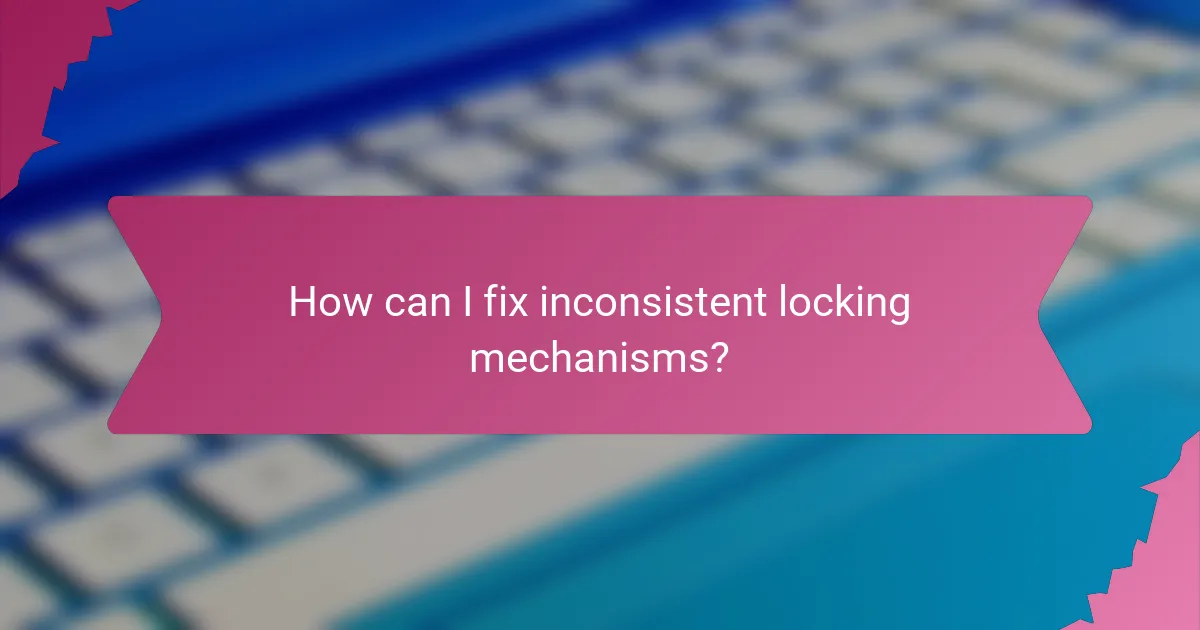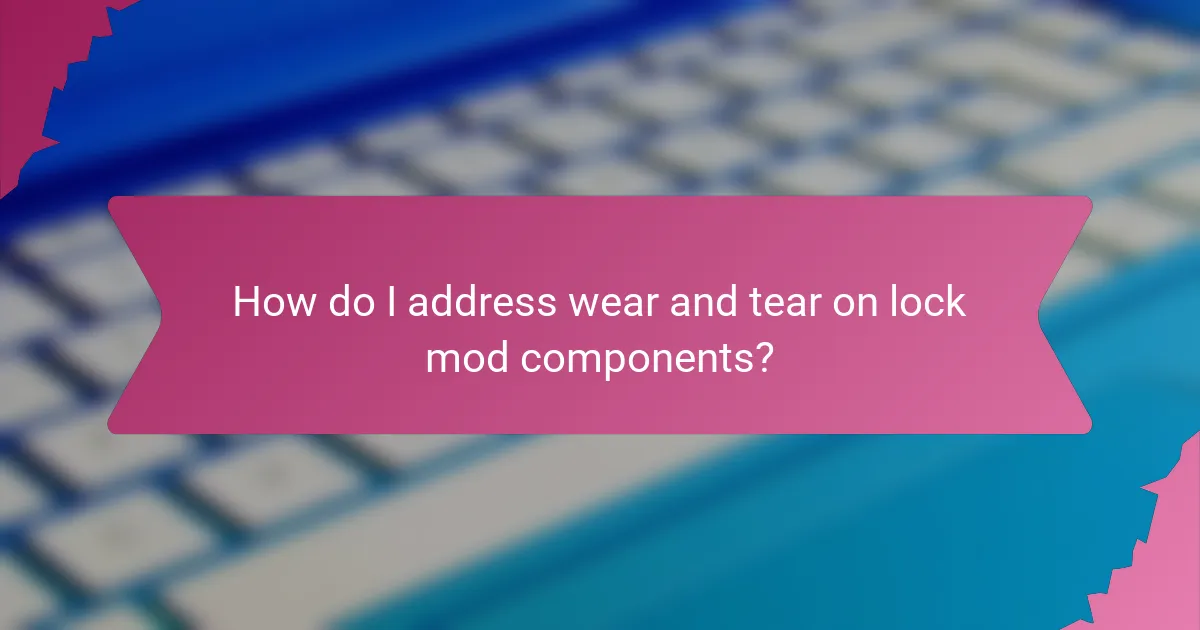Troubleshooting custom lock mods can be essential for maintaining their reliability and effectiveness. Common issues such as inconsistent performance, installation challenges, and electronic malfunctions may arise, but understanding these problems can lead to effective solutions. By addressing factors like alignment, component wear, and tension settings, you can restore optimal functionality to your locking system.

What are common issues with custom lock mods?
Common issues with custom lock mods include inconsistent performance, installation challenges, component wear, compatibility with existing hardware, and electronic malfunctions. Addressing these problems can enhance the reliability and effectiveness of your locking system.
Inconsistent locking mechanism
An inconsistent locking mechanism can lead to security vulnerabilities. This issue often arises from misalignment during installation or wear on the locking components. Regularly check the alignment and ensure that all parts are securely fastened to maintain proper function.
If you notice that the lock engages or disengages erratically, inspect the internal components for damage or debris. Cleaning and lubricating the mechanism can often resolve these inconsistencies.
Difficulty in installation
Installation difficulties are a common hurdle when customizing lock mods. Many users encounter challenges due to complex instructions or incompatible tools. Always read the manufacturer’s guidelines thoroughly before starting the installation process.
Consider using a step-by-step approach and having the right tools on hand, such as screwdrivers, pliers, and a level. If you’re unsure, consulting a professional can save time and ensure proper installation.
Wear and tear on components
Wear and tear on components is inevitable over time, especially with frequent use. Locks may experience degradation in their mechanical parts, leading to decreased performance. Regular maintenance, including cleaning and lubrication, can extend the lifespan of your lock mod.
Inspect components for signs of wear, such as rust or cracks, and replace them as needed. Keeping spare parts on hand can help you quickly address any issues that arise.
Compatibility problems with existing hardware
Compatibility problems often occur when custom lock mods are not designed to work with existing hardware. This can lead to installation failures or subpar performance. Before purchasing a lock mod, verify that it is compatible with your current locking system.
Check specifications and user reviews to ensure that others have successfully integrated the mod with similar hardware. If compatibility is uncertain, consider reaching out to the manufacturer for guidance.
Malfunctioning electronic components
Malfunctioning electronic components can significantly impact the functionality of electronic lock mods. Issues may arise from faulty wiring, dead batteries, or software glitches. Regularly test the electronic features to ensure they are operating correctly.
Replace batteries as needed and inspect wiring for any signs of damage. If problems persist, consult the user manual for troubleshooting tips or seek professional assistance to diagnose and fix the issue.

How can I fix inconsistent locking mechanisms?
To fix inconsistent locking mechanisms, first identify the root cause, which often involves adjusting tension settings, replacing worn-out springs, or lubricating moving parts. Addressing these common issues can restore reliable functionality to your lock system.
Adjust tension settings
Inconsistent locking can often stem from incorrect tension settings. Check the manufacturer’s guidelines for the ideal tension level, which usually falls within a specific range based on the lock type. Adjusting the tension can be done using a simple screwdriver or wrench, depending on your lock’s design.
When adjusting, make small changes and test the lock frequently. Over-tightening can lead to further issues, while too little tension may cause the lock to fail entirely. Aim for a balance that allows smooth operation without excessive force.
Replace worn-out springs
Worn-out springs are a common culprit behind locking inconsistencies. Inspect the springs for signs of wear, such as rust, bending, or breakage. If they appear damaged, replacing them is essential for restoring proper function.
When selecting replacement springs, ensure they match the original specifications in terms of size and strength. Using springs that are too weak or too strong can lead to further locking issues. Local hardware stores often carry a variety of springs, or you can order them from specialized suppliers.
Lubricate moving parts
Lack of lubrication can cause friction, leading to inconsistent locking performance. Regularly apply a suitable lubricant, such as graphite or silicone spray, to the moving parts of the lock. This helps ensure smooth operation and reduces wear over time.
Be cautious not to over-lubricate, as excess lubricant can attract dirt and debris, which may worsen the problem. A light application is usually sufficient. For best results, clean the lock before lubrication to remove any buildup that could impede function.

What are the installation challenges for custom lock mods?
Custom lock mods can present several installation challenges that may hinder their functionality. Common issues include improper alignment, insufficient tools, and complex wiring problems, each requiring specific attention to ensure a successful installation.
Improper alignment
Improper alignment is a frequent issue when installing custom lock mods, often leading to malfunction or damage. Ensure that all components are correctly positioned according to the manufacturer’s specifications, as even slight misalignments can affect the lock’s performance.
To avoid this, use a level and measuring tape during installation. Regularly check the alignment throughout the process to catch any discrepancies early on.
Insufficient tools
Having insufficient tools can significantly complicate the installation of custom lock mods. Essential tools typically include screwdrivers, pliers, and possibly specialized equipment depending on the mod’s complexity. Without the right tools, you may struggle to achieve a secure and functional installation.
Before starting, gather all necessary tools and consider investing in a quality toolkit that includes both common and specialized items. This preparation can save time and frustration during the installation process.
Complex wiring issues
Complex wiring issues can arise, especially with electronic lock mods. Incorrect wiring can lead to functionality problems or even damage to the lock system. It is crucial to follow wiring diagrams closely and understand the connections required for your specific mod.
If you encounter difficulties, refer to online resources or community forums for guidance. Additionally, consider consulting a professional if the wiring seems too complicated, as improper installation may void warranties or cause safety concerns.

How do I address wear and tear on lock mod components?
To address wear and tear on lock mod components, regular inspection and maintenance are essential. This ensures that any signs of damage are caught early, preventing further issues and extending the lifespan of your lock mod.
Regular maintenance schedule
Establishing a regular maintenance schedule is crucial for keeping lock mod components in optimal condition. Aim to inspect your lock mods every few months, or more frequently if they are used heavily. During these inspections, look for signs of wear, such as scratches, rust, or loose parts.
Consider creating a checklist for your maintenance routine. This can include cleaning components, lubricating moving parts, and checking for proper alignment. Regular upkeep can significantly reduce the likelihood of major repairs down the line.
Use high-quality materials
Using high-quality materials in your lock mod components can greatly reduce wear and tear. Opt for durable metals and robust plastics that can withstand regular use and environmental factors. Investing in better materials may have a higher upfront cost but can save money in the long run by minimizing replacements.
When selecting materials, look for those that are resistant to corrosion and wear. For example, stainless steel or anodized aluminum are excellent choices for components exposed to moisture. Always check product specifications to ensure they meet industry standards for durability.

What compatibility issues might arise with custom lock mods?
Compatibility issues with custom lock mods often stem from mismatched lock types or hardware specifications. Understanding these potential conflicts is crucial for ensuring that your modifications work seamlessly with existing systems.
Incompatible lock types
Different lock types, such as deadbolts, knob locks, and smart locks, may not be compatible with certain custom mods. For instance, a custom mod designed for a standard deadbolt may not fit or function properly with a smart lock system.
When selecting a custom lock mod, always check the manufacturer’s specifications to ensure compatibility with your existing lock type. If unsure, consult with a locksmith or the mod’s manufacturer for guidance.
Hardware limitations
Custom lock mods may also face hardware limitations, such as size constraints or specific mounting requirements. For example, a mod that requires a certain amount of space may not fit in a compact lock housing.
Before purchasing a custom mod, measure your existing lock and compare it against the mod’s dimensions. This helps avoid issues related to insufficient space or incompatible mounting points.
Electrical compatibility
For electronic or smart lock mods, electrical compatibility is vital. Ensure that the voltage and current requirements of the mod match your existing lock’s power supply. Mismatched electrical specifications can lead to malfunction or damage.
Check the specifications for both the lock and the mod, and consider consulting an electrician if you’re unsure about electrical compatibility. This step can save you from costly repairs or replacements.
